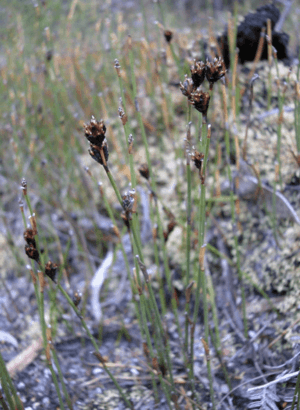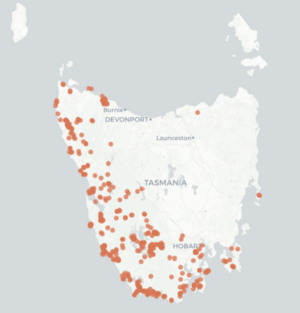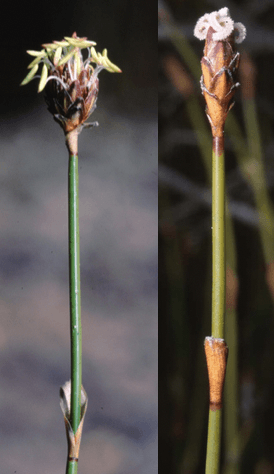Chordifex hookeri facts for kids
Quick facts for kids Chordifex hookeri |
|
|---|---|
 |
|
| Scientific classification | |
| Genus: |
Chordifex
|
| Species: |
hookeri
|
 |
|
| Distrubtion of Chordifex hookeri Atlas of Living Australia, Map data © OpenStreetMap, imagery © CartoDB | |
| Synonyms | |
|
|
Chordifex hookeri is a special plant often called woolly buttonrush or cord-rush. It's a type of rush, which is a plant that looks a bit like grass. This plant belongs to the Chordifex group and the Restionaceae family. What makes it unique is that it only grows in Tasmania, an island state of Australia.
Contents
What Does Woolly Buttonrush Look Like?
Chordifex hookeri grows from an underground stem called a rhizome. This stem can spread out about 20 centimeters (8 inches) and is about 6 millimeters wide. It has tiny hairs on it.
Stems and Leaves
The plant's leaves are very small, almost like scales. They have a sheath, which is a protective cover, up to 20 millimeters long. These sheaths are a bit loose and have soft, woolly hairs at their tips. The main stem, called a culm, is quite thin, usually between 0.75 and 1.75 millimeters wide.
Flowers and Seeds
The flowers of Chordifex hookeri grow in clusters called spikelets. These spikelets can be oval or round.
- Male flowers: These spikelets are about 7.5 to 8 millimeters long and contain several tiny flowers. Each male flower has three stamens, which are the parts that produce pollen.
- Female flowers: These spikelets are a bit smaller, about 6 to 7 millimeters long, and have fewer flowers. Each female flower has three staminodes, which are like stamens but don't produce pollen.
The flowers are protected by leaf-like parts called glumes, which also have woolly hairs. After flowering, the plant produces a small, two-part seed capsule about 3 millimeters long.
Where Does Woolly Buttonrush Grow?
Chordifex hookeri is found only in Tasmania. It is especially common in the South West region of Tasmania. You can see it in places like the Southwest National Park and the Southwest Conservation Area, where it grows in large numbers. It can also be found along the west coast, stretching up to the far north of the island.
What Kind of Home Does It Like?
This native plant prefers specific types of soil. It grows best in infertile, poorly-drained, and acidic peaty soil. This soil is often thin or rocky.
Soil and Environment
You can find Chordifex hookeri growing on different kinds of ground, including areas with dolerite, basalt, or quartzite gravels. However, it most commonly grows on sandy or rocky ground. The plant needs a lot of rain, as the areas where it grows usually have high annual rainfall.
Plant Communities
Chordifex hookeri is often found in certain plant communities:
- Buttongrass moorlands: These are open areas dominated by buttongrass. Here, Chordifex hookeri grows as part of the lower plant layer and can be a main species on slopes.
- Lowland sedgelands: In these areas, it grows in sandy gravel on infertile soil and is a dominant plant.
- Restionaceae rushland: This plant is a dominant species in these rushlands, growing in deep peaty soil.
It can grow from areas near the sea all the way up to about 1000 meters (3,280 feet) in altitude. For example, on Mt. Sprent, it's found at 620 meters (2,034 feet) in buttongrass and alpine moorland. Frequent fires in these areas help control other plants from growing too large, which allows Chordifex hookeri to thrive.


